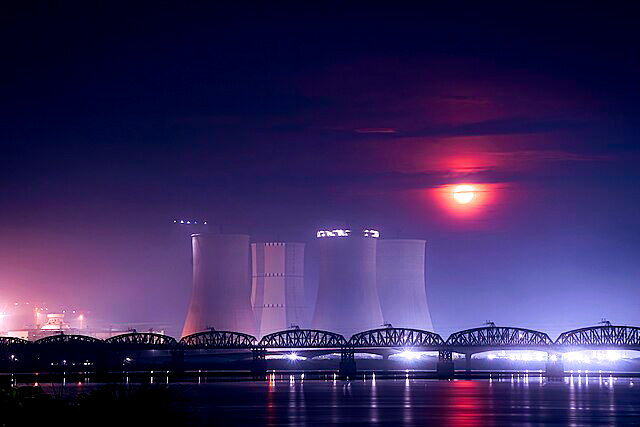What is the first thing that comes to mind when you hear the words “clean energy”? For many it brings images of solar panels or wind farms. What is not thought of is nuclear power.
Microsoft and Google have well established carbon-neutral goals. However the rapid rise of AI has caused an explosion in energy needs for these tech giants, and to meet the energy requirements of their AI development they have gone to an unexpected source: nuclear reactors.
According to an article from The Guardian about Google’s purchase of new nuclear technology:
“[…]Last month, Microsoft struck a deal to take energy from Three Mile Island, activating the nuclear plant for the first time in five years[…]
The locations of the new Google plants and financial details of the agreement were not revealed. The tech company has agreed to buy a total of 500 megawatts of power from Kairos, which was founded in 2016 and is building a demonstration reactor in Tennessee, due to be completed in 2027.”
In addition, an article from Reuters covering the Microsoft deals also mentions a nuclear fusion deal:
“Microsoft has also signed a power purchase agreement with Washington-state fusion company Helion, which says the plant will be online by 2028, far earlier than many scientists say fusion will become commercial.”
The reactors that Google is purchasing from Kairos are known as small modular reactors, often reduced to SMRs. On top of that, Microsoft is choosing to make a risky investment into Helions technology and restarting a reactor at the infamous Three Mile Island. The Kairos reactors are theoretically sound however SMRs have seen limited use and are uncharted territory. However, that seems like a safe investment compared to Microsoft choosing to put money into fusion that claims to be operational by 2028–which many scientists would equate to expecting to generate power from hopes, dreams, and unicorn farts. Finally, someone managed to convince the Microsoft PR team that restarting one of the units at the site of the partial meltdown in March of 1979.
These sudden decisions by tech giants raise some fair questions. Why do these companies suddenly have an urgent need for so much electricity and why choose nuclear rather than more typical alternatives such as fossil fuels, solar, or wind?
Firstly, the development of AI technology is proving to require drastic amounts of energy. According to an article from The Verge in February 2024:
“The agency says current data center energy usage stands at around 460 terawatt hours in 2022 and could increase to between 620 and 1,050 TWh in 2026 — equivalent to the energy demands of Sweden or Germany, respectively.”
While data center refers to more than AI, the data centers being built by big tech companies at the moment are largely for that purpose, and it is no wonder that they need so much energy as the data centers are devouring as much energy as first world countries.
Secondly, these corporations cannot lean on more traditional means due to climate pledges and technological limitations. Big tech has long said that they will try to reach net-zero carbon emissions in the near future as Google Sustainability has set a goal in a release:
“At Google, our goal is to achieve net-zero emissions across all of our operations and value chain by 2030”
Also, Brad Smith, president and vice-chair of Microsoft, outlining on the Official Microsoft Blog in January 2020 the companies climate goals:
“By 2030 Microsoft will be carbon negative, and by 2050 Microsoft will remove from the environment all the carbon the company has emitted either directly or by electrical consumption since it was founded in 1975.”
With lofty goals such as becoming carbon neutral at such a pace, using fossil fuels to supplement so much power would come at a cost to their timelines and reputation. However, carbon does not explain why they would not use the same solar and wind they have advocated for as a solution to that very problem. So what is the problem with typical renewables? The difference is that nuclear is a consistent source in comparison to the intermittent renewable plants. Renewable plants often are forced to wait for routine maintenance or on the unreliable fuels they require. In contrast, a nuclear plant is built to last without much maintenance or refueling for more than a year. A 2021 article from energy.gov has provided the resulting data on the capacity factors of these plants:
“The capacity factors for various sources are: Nuclear has 92.5%, wind has 35.4%, and solar has 24.9%[…] Nuclear power plants are typically used more often because they require less maintenance and are designed to operate for longer stretches before refueling (typically every 1.5 or 2 years). Natural gas and coal capacity factors are generally lower due to routine maintenance and/or refueling at these facilities. Renewable plants are considered intermittent or variable sources and are mostly limited by a lack of fuel (i.e. wind, sun, or water).”
A capacity factor is the ratio of how much energy a plant is generating to how much energy it would produce if it were producing at maximum capacity for the entire time period. So a one gigawatt nuclear plant will on average be producing at full power 92% of the time while a renewable power plant will on average only only produce at full power roughly 25% to 35% of the time. They may be helpful for supplementing a grid, but renewable plants are not consistent enough to meet modern energy needs with current technology.
What most people might not see is the possible environmental benefits of using nuclear power. In an article about nuclear fun facts energy.gov touched on one of these main benefits:
“A typical 1,000-megawatt nuclear facility in the United States needs a little more than 1 square mile to operate. NEI says wind farms require 360 times more land area to produce the same amount of electricity and solar photovoltaic plants require 75 times more space.”
Taking up that land can ruin habitats for local flora and fauna. The sprawling renewable plants can actually be very disruptive to their ecosystems while nuclear plants are dense and contained. This way more land can be left open for wildlife reservations and in some cases possibly development.
It is refreshing to see that these tech giants are willing to make an unexpected change even though the move to nuclear is a surprisingly logical move for these corporations as it meets all their needs while also having some unexpected advantages. Perhaps as energy demands rise we should all consider going nuclear.









